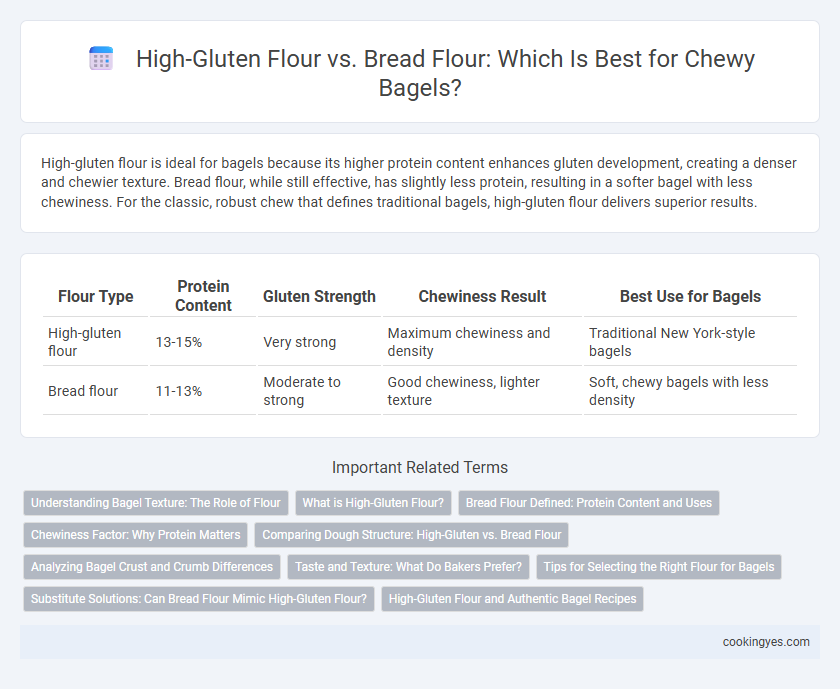High-gluten flour is ideal for bagels because its higher protein content enhances gluten development, creating a denser and chewier texture. Bread flour, while still effective, has slightly less protein, resulting in a softer bagel with less chewiness. For the classic, robust chew that defines traditional bagels, high-gluten flour delivers superior results.
Table of Comparison
| Flour Type | Protein Content | Gluten Strength | Chewiness Result | Best Use for Bagels |
|---|---|---|---|---|
| High-gluten flour | 13-15% | Very strong | Maximum chewiness and density | Traditional New York-style bagels |
| Bread flour | 11-13% | Moderate to strong | Good chewiness, lighter texture | Soft, chewy bagels with less density |
Understanding Bagel Texture: The Role of Flour
High-gluten flour contains more protein than bread flour, which contributes to the chewy texture characteristic of traditional bagels by developing stronger gluten networks during mixing and baking. Bread flour, while still higher in protein than all-purpose flour, tends to produce a slightly softer crumb and less chewiness compared to high-gluten flour. Understanding the protein content and gluten development in different flours is essential for achieving the dense, elastic texture that defines authentic bagels.
What is High-Gluten Flour?
High-gluten flour contains a protein content ranging from 12.5% to 14.5%, significantly higher than bread flour's 11% to 13%. This elevated protein level in high-gluten flour develops a stronger gluten network, providing the characteristic dense chewiness essential for authentic bagels. Using high-gluten flour ensures the bagel dough achieves maximum elasticity and a firm, chewy texture unmatched by bread flour.
Bread Flour Defined: Protein Content and Uses
Bread flour, characterized by a protein content of 11-13%, is designed to develop strong gluten networks essential for chewy bagels. This moderate protein level enables optimal elasticity and structure, balancing chewiness without the toughness often caused by high-gluten flour, which typically exceeds 14% protein. Ideal for bagels, bread flour supports a durable crumb and chewy texture, making it a preferred choice over high-gluten flour for home bakers seeking the classic bagel bite.
Chewiness Factor: Why Protein Matters
High-gluten flour, with its protein content ranging from 13% to 14.5%, creates a stronger gluten network that enhances bagel chewiness and structure. Bread flour, containing slightly less protein at 11% to 13%, offers moderate gluten development resulting in a softer chew. The higher protein in high-gluten flour directly impacts the elasticity and chewiness that define an authentic bagel texture.
Comparing Dough Structure: High-Gluten vs. Bread Flour
High-gluten flour contains 12-14% protein, providing stronger gluten networks that result in denser, chewier bagels with better elasticity. Bread flour, with 11-13% protein, produces a slightly softer crumb and less robust chew due to its lower gluten content. The dough structure of high-gluten flour creates superior gas retention and a more resilient texture, essential for classic bagel chewiness.
Analyzing Bagel Crust and Crumb Differences
High-gluten flour, containing 12-14% protein, creates a denser and chewier crust and crumb in bagels compared to bread flour, which has a slightly lower protein content of 10-12%. The increased gluten strength in high-gluten flour develops a tighter and more elastic dough structure, resulting in the iconic bagel chewiness and a glossy, firm crust. Bread flour yields a lighter crumb with less resistance, producing softer bagels that lack the traditional chewy texture found in authentic bagels made with high-gluten flour.
Taste and Texture: What Do Bakers Prefer?
High-gluten flour, with its protein content typically between 12-14%, creates a denser and chewier bagel texture favored by artisan bakers seeking authentic New York-style bagels. Bread flour, containing slightly less protein around 11-13%, yields a softer crumb but sacrifices the pronounced chewiness prized in traditional bagels. Professional bakers prefer high-gluten flour for its superior gluten network development, which enhances both the bagel's bite and its ability to hold up during boiling and baking, delivering a satisfying texture and robust flavor.
Tips for Selecting the Right Flour for Bagels
High-gluten flour, containing 14-15% protein, is ideal for achieving the traditional dense and chewy texture of bagels, as it develops more gluten strength compared to bread flour's 12-14% protein content. Selecting the right flour depends on desired chewiness; using high-gluten flour ensures better elasticity and a classic bagel bite, while bread flour may result in slightly softer texture. For best results, combine high-gluten flour with proper kneading and fermentation techniques to maximize chewiness and structure in bagel dough.
Substitute Solutions: Can Bread Flour Mimic High-Gluten Flour?
Bread flour, with a protein content typically around 12-14%, offers a decent chewiness but falls short of the 14-15% protein found in high-gluten flour essential for authentic bagel texture. To mimic high-gluten properties, bakers can combine bread flour with vital wheat gluten, enhancing dough strength and elasticity to achieve the characteristic bagel chew. This substitution not only improves gluten development but also maintains dough structure during boiling and baking, resulting in a chewy crust and dense crumb comparable to bagels made with high-gluten flour.
High-Gluten Flour and Authentic Bagel Recipes
High-gluten flour, containing 14-15% protein, is essential for achieving the signature chewiness of authentic bagel recipes, as its strong gluten network provides superior elasticity and structure compared to bread flour's 12-14% protein. Authentic New York-style bagels rely on high-gluten flour to create their dense, chewy crumb and glossy crust, which cannot be replicated with lower-protein breads. Using high-gluten flour ensures the traditional texture and mouthfeel that defines classic, artisanal bagels.
High-gluten flour vs bread flour for bagel chewiness Infographic

 cookingyes.com
cookingyes.com